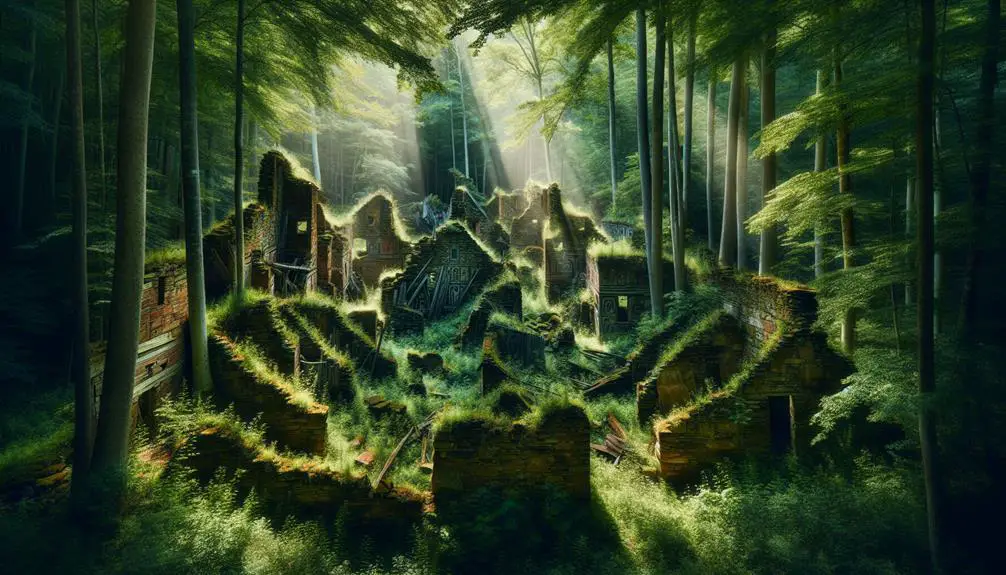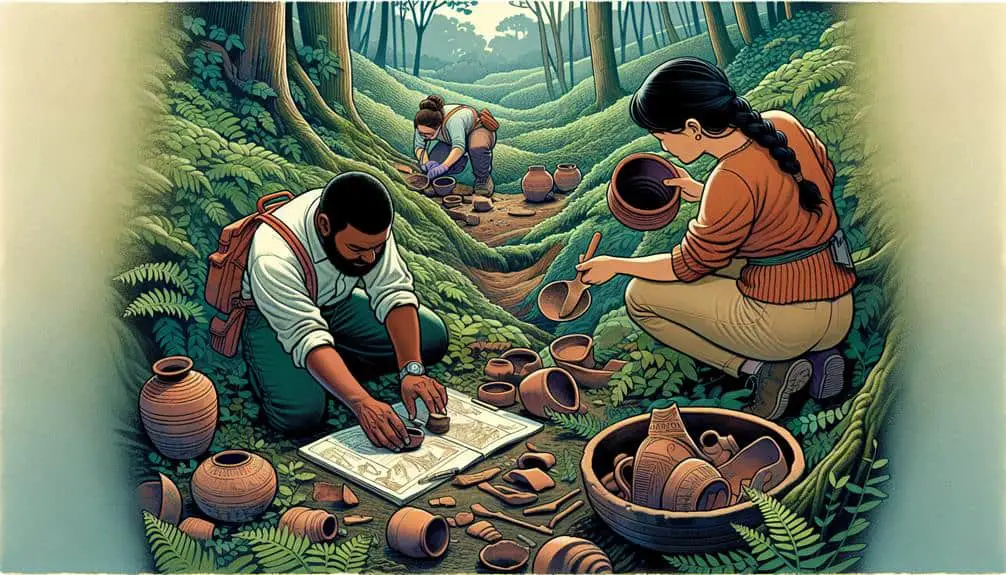Discover the enduring enigma behind mysterious Native American village remnants. These remnants exist as tangible remnants of a bygone era, offering a unique window into ancient traditions and societal structures. Vital conservation efforts play a pivotal role in unraveling their historical significance. By studying these remnants, you can unearth insights into cultural practices, tools, materials, and social organization. Each artifact and structure tells a compelling story waiting to be explored further. Their survival whispers tales of resilience and heritage worth uncovering. Explore these remnants for a deeper understanding of Native American history and cultural richness.
Key Points
- Provide insights into ancient societal structures and cultural practices.
- Uncover valuable information about materials, tools, and economic activities.
- Preservation efforts aim to maintain tangible connections to the past.
- Archaeological discoveries reveal historical mysteries and enrich knowledge.
- Cultural and spiritual significance as sacred sites with profound meaning.
Historical Significance of Village Remnants
The historical importance of Native American village remnants lies in their ability to provide tangible connections to the past, offering insights into the daily lives, cultural practices, and societal structures of indigenous communities. Conservation methods and research play a vital role in preserving these remnants, allowing for a deeper understanding of indigenous perspectives and artifacts.
Through meticulous conservation methods, researchers can uncover valuable information about the materials used in constructing these villages, the tools employed for various tasks, and the food sources relied upon by these communities. By studying these remnants, historians gain a clearer picture of the social organization, religious beliefs, and economic activities of Native American tribes.
Indigenous perspectives are essential in interpreting the significance of village remnants. By incorporating the viewpoints of descendants of these communities, researchers can guarantee that the cultural heritage embedded in these artifacts is respected and understood accurately. This collaboration between indigenous communities and researchers enhances the preservation efforts and contributes to a more detailed narrative of Native American history.
Preservation Efforts and Challenges
Preserving Native American village remnants poses various challenges that require innovative conservation strategies. One of the primary challenges faced is balancing preservation with public access. It's essential to protect these sites while also allowing people to visit and learn about their significance.
Additionally, natural elements like erosion, vegetation growth, and weathering constantly threaten the integrity of these remnants, demanding ongoing maintenance and protection efforts.
To combat these challenges, preservation methods such as strategic fencing, controlled vegetation removal, and regular site monitoring have been implemented. These strategies help safeguard the remnants without compromising their historical value.
Furthermore, community involvement plays an important role in preservation efforts. By engaging with local tribes and incorporating their traditional knowledge, a deeper understanding of the sites can be achieved, leading to more effective conservation practices.
Despite the obstacles faced, the dedication to preserving Native American village remnants persists through the development of innovative techniques and the collaboration of various stakeholders. By overcoming these challenges, these remnants can continue to serve as valuable historical and cultural resources for generations to come.
Archaeological Discoveries and Insights
Unearthing ancient artifacts and unraveling historical mysteries, archaeological discoveries at Native American village remnants provide profound insights into the past. Through meticulous excavation techniques, researchers have unearthed a plethora of ancient artifacts that offer a glimpse into the daily lives, rituals, and technologies of these ancient communities. Pottery shards, tools, burial sites, and even remnants of structures have all been discovered, shedding light on the cultural practices and societal structures of these villages.
Excavation techniques such as stratigraphy, radiocarbon dating, and ground-penetrating radar have been instrumental in piecing together the puzzle of these ancient settlements. By carefully documenting the layers of soil and artifacts found at these sites, archaeologists can create a timeline of events and activities that occurred in these villages centuries ago.
The study of these ancient artifacts not only enriches our historical knowledge but also helps us appreciate the resilience and ingenuity of the Native American peoples who inhabited these villages. Through these discoveries, we can better understand and honor the legacy of these communities that have left their mark on the landscape of history.
Cultural and Spiritual Relevance
Delving into the cultural and spiritual significance of Native American village remnants reveals a rich tapestry of traditions and beliefs that have endured for generations. These remnants aren't merely archaeological artifacts but serve as sacred sites imbued with profound meaning and significance. For many Native American communities, these village remnants aren't just physical remains but living connections to their ancestors and heritage.
Sacred sites hold immense spiritual importance, serving as places where rituals, ceremonies, and prayers are conducted to honor the land, ancestors, and spirits. They're seen as portals to the past, allowing present generations to forge strong ancestral connections and maintain cultural continuity. The village remnants act as tangible links to the past, reminding people of their roots and the enduring legacy of their predecessors.
Ancestral connections are deeply intertwined with the cultural fabric of Native American societies, fostering a sense of belonging and identity. The village remnants stand as affirmations to the resilience and wisdom of past generations, guiding and inspiring the present and future.
Impact of Modern Development
The encroachment of modern development poses a significant challenge to the preservation and protection of Native American village remnants. As urbanization spreads, the environmental effects on these historical sites become increasingly concerning. Construction projects, deforestation, and pollution can irreversibly damage the delicate ecosystems surrounding these villages, threatening the integrity of archaeological remains and disrupting the balance of the natural environment.
Moreover, modern development often leads to community displacement, as indigenous populations are forced to relocate due to infrastructure expansion. This displacement not only severs the connection between Native American communities and their ancestral lands but also disrupts the traditional practices and cultural heritage tied to these village remnants. The influx of outsiders into these areas can further exacerbate the situation, leading to the exploitation of resources and the commercialization of sacred sites, diminishing their cultural and historical significance.
In order to mitigate these detrimental effects, it's imperative to implement sustainable development practices that prioritize the conservation of Native American village remnants and respect the rights of indigenous communities to protect their heritage for future generations.
Frequently Asked Questions
How Do Modern Native American Communities View and Interact With These Mysterious Village Remnants?
In modern Native American communities, perspectives on mysterious village remnants vary. Some view these remnants as essential links to their cultural heritage, while others see them as haunting reminders of a painful past. Cultural preservation efforts play a significant role in shaping interactions with these sites.
Are There Any Legends or Oral Traditions Passed Down Through Generations That Mention These Village Remnants?
Legends and oral traditions among Native American communities speak of the significance of these village remnants, preserving cultural heritage. Passed down through generations, these stories offer insights into the past and guide efforts for preservation.
What Potential Challenges Do Archaeologists Face in Studying These Remnants Compared to More Well-Known Sites?
When examining lesser-known sites, challenges arise for archaeologists in preservation techniques and data collection. These remnants lack the resources and recognition of famous sites, making their study more difficult and requiring innovative approaches.
Have There Been Any Attempts to Incorporate These Village Remnants Into Educational Programs or Tourism Initiatives?
You might be surprised to learn about the remarkable efforts in cultural preservation and economic development through incorporating village remnants into educational programs and tourism initiatives. These sites hold historical significance and offer unique educational opportunities.
Are There Any Ongoing Research Projects or Initiatives Focused Specifically on Unraveling the Mysteries Surrounding These Village Remnants?
Are ongoing research projects focused on unraveling the mysteries surrounding these village remnants? Explore current excavation techniques and preservation efforts to understand the cultural significance. Discover various initiatives shedding light on these historical enigmas.



